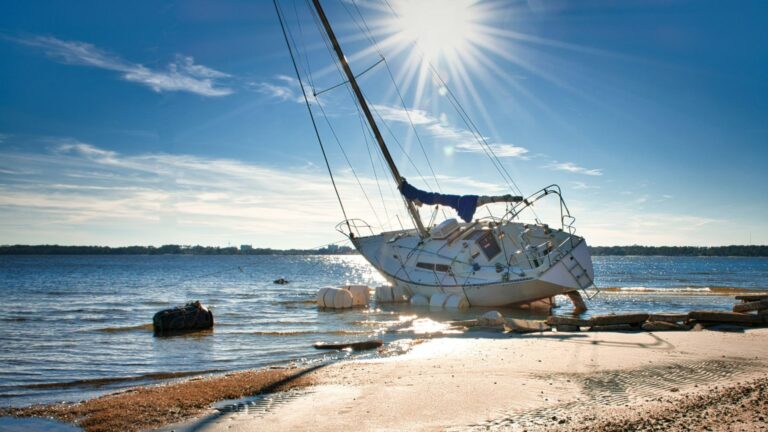So, you’ve got a boat. You’ve been frolicking through sunny summer days, cocktail in hand, wind in your hair, sea spray gently misting your face like some kind of nautical shampoo commercial. And then… November rolls in. The temperature drops, marinas get quiet, and most boaters retreat to land like hibernating bears.
But not you.
You’re thinking, “Wait… can you sail in winter?”
Oh yes.
Should you? That’s a much longer conversation—but one that we’re absolutely having right now.
Welcome to the crisp, icy, wind-chapped world of winter sailing, where your love for the water is tested harder than your snow tires in a Canadian parking lot. Let’s dive in (figuratively—we do not recommend diving into icy water) to why people do this, how you can survive it, and whether or not you’re ready to join this frosty cult.
Because Icebergs Are Just Spicy Buoys, Right?
Why Sail in Winter? (Are You Okay?)
Winter sailing is like regular sailing, except the water is colder, the wind is angrier, and you wear more layers than a toddler at daycare. But weirdly… it’s kind of magical.
1. No Crowds, No Chaos
During the summer, the water is filled with boats, jet skis, floating unicorns, and that one guy with a Bluetooth speaker blasting Bon Jovi. But in winter? Solitude. Silence. Serenity. You have the sea (almost) to yourself. It’s like getting VIP access to nature.
2. Winter Wind Is Chef’s Kiss
Colder air is denser, and denser air means more power in your sails. Winter winds are often steadier, stronger, and sassier than the gusty, squirrel-on-caffeine summer breezes. If you’re the kind of sailor who dreams of speed, this is your season.
3. It’s Beautiful in a Post-Apocalyptic Way
There’s something breathtaking about icy coastlines, snow-dusted decks, and misty harbors. The low sun on a calm winter afternoon can turn even a crusty marina into a painting. Add a thermos of hot cocoa, and you’ve got peak romantic seafaring vibes.
4. You’re a Hardcore Legend Now
Let’s face it—sailing in the cold is a badge of honor. Your friends will gasp in horror. Strangers will respect you. Other sailors will either salute you… or call you mad. Either way, your story will include words like “ice floes,” “hypothermia risk,” and “character-building.”
How to Actually Survive It (And Maybe Even Enjoy It)
Sailing in winter isn’t just about enthusiasm—it’s also about preparation, gear, and knowing when to say, “Nope, too frozen.”
1. Layer Like an Onion (That’s Also a Sailor)
Forget flip-flops. You need:
- A solid base layer (merino wool is your new best friend)
- A warm mid-layer (fleece, synthetic insulation, or that hoodie you stole from your ex)
- A waterproof and windproof outer shell (jacket and bibs—bonus points if you look like a colorful snow crab)
Also: gloves, a hat, and waterproof boots with thick socks. Because nothing ruins a romantic winter sail like foot-frostbite.
2. Check the Weather Like It Owes You Money
Winter weather is wild. One minute it’s a light breeze, the next it’s a scene from The Day After Tomorrow. Always:
- Check multiple forecasts
- Know local patterns (will it suddenly snow sideways?)
- Have an escape plan (aka, a warm pub nearby)
If it looks sketchy, don’t go. The sea will still be there tomorrow, looking cold and mysterious.
3. Keep Your Boat from Becoming a Popsicle
- Insulate your engine and keep it warm with a heating pad or engine jacket.
- Drain water tanks and lines unless you like surprises that smell like mildew and regret.
- Use anti-freeze in your heads, sinks, and bilge pumps—marine-grade only, please, unless you want your boat to smell like peppermint chemicals.
4. Bring Hot Drinks. All the Hot Drinks.
Nothing boosts morale faster than a steaming mug of something:
- Coffee for focus
- Tea for coziness
- Hot chocolate for joy
- Soup in a thermos, because you are a genius
- Whiskey, later, safely docked, while reliving your near-death tacking maneuver
Winter Sailing Warning Label
Let’s be real: sailing in winter comes with some serious risks. It’s important to be aware of:
- Hypothermia: Falling overboard in cold water can be fatal in minutes. Wear a PFD (a good one!), consider a drysuit, and have a “man overboard” plan.
- Reduced daylight: The sun is lazy in winter. Plan for earlier returns and avoid sailing into the inky, terrifying darkness.
- Frozen gear: Winches, lines, zippers, and steering cables can freeze. Test everything before you leave the dock.
- Mental fatigue: Cold = tired = bad decisions. Keep your crew warm and your brain engaged.
The Secret Joy of Cold-Weather Sailing
There’s something wildly satisfying about sailing when everyone else has gone home. It’s raw. It’s peaceful. It’s adventurous in a way summer never quite is. It’s you, your boat, and the sea—frosty, unforgiving, and beautiful.
You’ll come back from a winter sail with chapped lips, windburn, stories to tell, and maybe a few icicles on your rigging. But you’ll also come back with a deep sense of, “I did that.” And that feeling? Worth every frozen toe.
Final Thought: You’re Not Crazy—You’re a Sailor
So, should you sail in winter?
If you’re prepared, careful, well-dressed, and a little bit brave—then absolutely. Winter sailing isn’t just about pushing limits. It’s about reconnecting with why you fell in love with sailing in the first place: the freedom, the quiet, the wonder.
And hey, when you return to port and someone asks, “Were you just sailing in January?” you get to raise an eyebrow, sip your cocoa, and say:
“Of course I was.”
Want a checklist for safe winter sailing prep? Or a guide to winterizing your boat without turning it into a science experiment? I’ve got you covered—just say the word!




